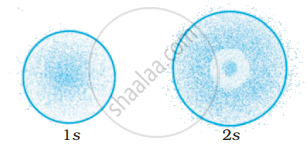Advertisements
Advertisements
प्रश्न
Write orbital notations for the electron in orbitals with the following quantum numbers.
n = 3, l = 2
उत्तर
3d
APPEARS IN
संबंधित प्रश्न
Using s, p, d notations, describe the orbital with the following quantum numbers n = 1, l = 0.
Using s, p, d notations, describe the orbital with the following quantum numbers n = 3; l =1.
Using s, p, d notations, describe the orbital with the following quantum numbers n = 4; l =3.
Give the names of quantum numbers.
Define the term Electronic configuration
State and explain Pauli’s exclusion principle.
State the order of filling atomic orbitals following Aufbau principle.
Explain the anomalous behaviour of copper.
Explain the anomalous behaviour of chromium.
Write electronic configurations of \[\ce{Fe, Fe2+, Fe3+}\].
Write condensed orbital notation of electronic configuration of the following element:
Carbon (Z = 6)
The electronic configuration of oxygen is written as 1s2 2s2 \[\ce{2p^2_{{x}}}\] \[\ce{2p^1_{{y}}}\] \[\ce{2p^1_{{z}}}\] and not as 1s2 2s2 \[\ce{2p^2_{{x}}}\], \[\ce{2p^2_{{y}}}\] \[\ce{2p^0_{{z}}}\], Explain.
Write a note on ‘Principal Quantum number.
Which of the following has a greater number of electrons than neutrons?
(Mass number of Mg, C, O and Na is 24, 12, 16 and 23 respectively).
The probability density plots of 1s and 2s orbitals are given in Figure:

The density of dots in a region represents the probability density of finding electrons in the region.
On the basis of above diagram which of the following statements is incorrect?
The number of radial nodes for 3p orbital is ______.
In which of the following pairs, the ions are iso-electronic?
(i) \[\ce{Na^{+}, Mg^{2+}}\]
(ii) \[\ce{Al3^{+}, O-}\]
(iii) \[\ce{Na+ , O2-}\]
(iv) \[\ce{N3-, Cl-}\]
Which of the following statements concerning the quantum numbers are correct?
(i) Angular quantum number determines the three dimensional shape of the orbital.
(ii) The principal quantum number determines the orientation and energy of the orbital.
(iii) Magnetic quantum number determines the size of the orbital.
(iv) Spin quantum number of an electron determines the orientation of the spin of electron relative to the chosen axis.
Which of the following orbitals are degenerate?
3dxy, 4dxy 3dz2, 3dyz, 4dyz, 4dz2
The arrangement of orbitals on the basis of energy is based upon their (n + l) value. Lower the value of (n + l), lower is the energy. For orbitals having same values of (n + l), the orbital with lower value of n will have lower energy.
Based upon the above information, arrange the following orbitals in the increasing order of energy.
1s, 2s, 3s, 2p
The arrangement of orbitals on the basis of energy is based upon their (n + l) value. Lower the value of (n + l), lower is the energy. For orbitals having same values of (n + l), the orbital with lower value of n will have lower energy.
Based upon the above information, arrange the following orbitals in the increasing order of energy.
5p, 4d, 5d, 4f, 6s
The arrangement of orbitals on the basis of energy is based upon their (n + l) value. Lower the value of (n + l), lower is the energy. For orbitals having same values of (n + l), the orbital with lower value of n will have lower energy.
Based upon the above information, arrange the following orbitals in the increasing order of energy.
5f, 6d, 7s, 7p
The arrangement of orbitals on the basis of energy is based upon their (n + l) value. Lower the value of (n + l), lower is the energy. For orbitals having same values of (n + l), the orbital with lower value of n will have lower energy.
Based upon the above information, solve the questions given below:
Which of the following orbitals has the lowest energy?
4d, 4f, 5s, 5p
Match the following species with their corresponding ground state electronic configuration.
| Atom / Ion | Electronic configuration |
| (i) \[\ce{Cu}\] | (a) 1s2 2s2 2p6 3s2 3p6 3d10 |
| (ii) \[\ce{Cu^{2+}}\] | (b) 1s2 2s2 2p6 3s2 3p6 3d10 4s2 |
| (iii) \[\ce{Zn^{2+}}\] | (c) 1s2 2s2 2p6 3s2 3p6 3d10 4s1 |
| (iv) \[\ce{Cr^{3+}}\] | (d) 1s2 2s2 2p6 3s2 3p6 3d9 |
| (e) 1s2 2s2 2p6 3s2 3p6 3d3 |
Match the quantum numbers with the information provided by these.
| Quantum number | Information provided |
| (i) Principal quantum number | (a) orientation of the orbital |
| (ii) Azimuthal quantum number | (b) energy and size of orbital |
| (iii) Magnetic quantum number | (c) spin of electron |
| (iv) Spin quantum number | (d) shape of the orbital |
Which of the following is the correct plot for the probability density ψ2 (r) as a function of distance 'r' of the electron from the nucleus for 2s orbitals?
Which of the following element do not follow Aufbau principle?
Which one of the following laws will represent the pairing of electrons in a subshell after each orbital is filled with one electron?
